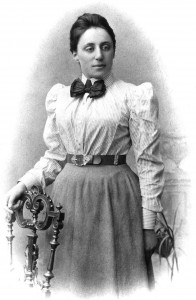 Most non-mathematicians have probably heard of Euclid, Pythagoras, Poincaré, Gauss, Lagrange, de Fermat, and Hilbert, to name but a few. All giants in their various mathematical specialties. But, I would hazard a wager that even most mathematicians have never heard of Noether. Probably because Emmy Noether is a woman.
Most non-mathematicians have probably heard of Euclid, Pythagoras, Poincaré, Gauss, Lagrange, de Fermat, and Hilbert, to name but a few. All giants in their various mathematical specialties. But, I would hazard a wager that even most mathematicians have never heard of Noether. Probably because Emmy Noether is a woman.
Yet learning of her exploits in the early 20th century, I can see how far we still have to travel to truly recognize the contributions of women in academia and science — and everywhere else for that matter — as on a par with those of men. Women like Noether succeeded despite tremendous (male) pressure against them, which makes their achievements even more astonishing.
From ars technica:
By 1915, any list of the world’s greatest living mathematicians included the name David Hilbert. And though Hilbert previously devoted his career to logic and pure mathematics, he, like many other critical thinkers at the time, eventually became obsessed with a bit of theoretical physics.
With World War I raging on throughout Europe, Hilbert could be found sitting in his office at the great university at Göttingen trying and trying again to understand one idea—Einstein’s new theory of gravity.
Göttingen served as the center of mathematics for the Western world by this point, and Hilbert stood as one of its most notorious thinkers. He was a prominent leader for the minority of mathematicians who preferred a symbolic, axiomatic development in contrast to a more concrete style that emphasized the construction of particular solutions. Many of his peers recoiled from these modern methods, one even calling them “theology.” But Hilbert eventually won over most critics through the power and fruitfulness of his research.
For Hilbert, his rigorous approach to mathematics stood out quite a bit from the common practice of scientists, causing him some consternation. “Physics is much too hard for physicists,” he famously quipped. So wanting to know more, he invited Einstein to Göttingen to lecture about gravity for a week.
Before the year ended, both men would submit papers deriving the complete equations of general relativity. But naturally, the papers differed entirely when it came to their methods. When it came to Einstein’s theory, Hilbert and his Göttingen colleagues simply couldn’t wrap their minds around a peculiarity having to do with energy. All other physical theories—including electromagnetism, hydrodynamics, and the classical theory of gravity—obeyed local energy conservation. With Einstein’s theory, one of the many paradoxical consequences of this failure of energy conservation was that an object could speed up as it lost energy by emitting gravity waves, whereas clearly it should slow down.
Unable to make progress, Hilbert turned to the only person he believed might have the specialized knowledge and insight to help. This would-be-savior wasn’t even allowed to be a student at Göttingen once upon a time, but Hilbert had long become a fan of this mathematician’s highly “abstract” approach (which Hilbert considered similar to his own style). He managed to recruit this soon-to-be partner to Göttingen about the same time Einstein showed up.
And that’s when a woman—one Emmy Noether—created what may be the most important single theoretical result in modern physics.
…
During Noether’s stay at Göttingen, Hilbert contrived a way to allow her to lecture unofficially. He repeatedly attempted to get her hired as a Privatdozent, or an officially recognized lecturer. The science and mathematics faculty was generally in favor of this, but Hilbert could not overcome the resistance of the humanities professors, who simply could not stomach the idea of a female teacher. At one meeting of the faculty senate, frustrated again in his attempts to get Noether a job, he famously remarked, “I do not see that the sex of a candidate is an argument against her admission as Privatdozent. After all, we are a university, not a bathing establishment.”
Social barriers aside, Noether immediately grasped the problem with Einstein’s theory. Over the course of three years, she not only solved it, but in doing so she proved a theorem that simultaneously reached back to the dawn of physics and pushed forward to the physics of today. Noether’s Theorem, as it is now called, lies at the heart of modern physics, unifying everything from the orbits of planets to the theories of elementary particles.
Read the entire story here.
Image: Emmy Noether (1882-1935). Public domain.
